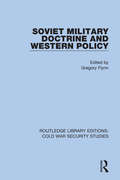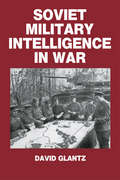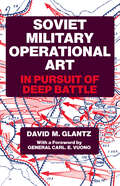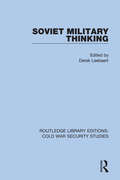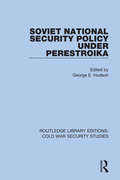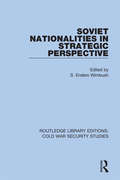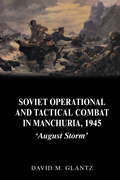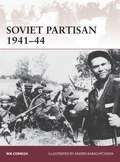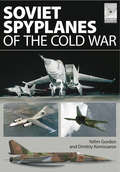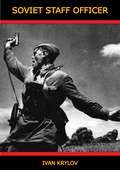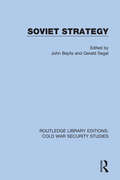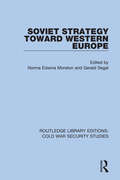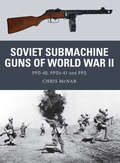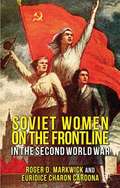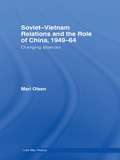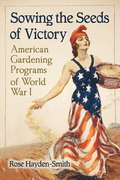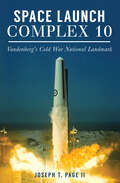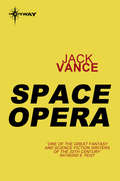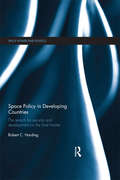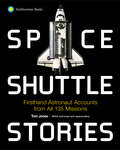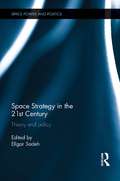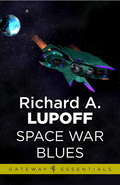- Table View
- List View
Soviet Military Doctrine and Western Policy (Routledge Library Editions: Cold War Security Studies #49)
by Gregory FlynnThis book, first published in 1989, analyses Western and Soviet perceptions of each other’s military thoughts and doctrines, a key part of the Cold War, where both sides planned to both win a possible conflict, and to avoid one. The work demonstrates that both East and West made judgments about each other’s military profile on the basis of political preconceptions.
Soviet Military Intelligence in War (Soviet (Russian) Military Theory and Practice)
by Colonel David GlantzThis text is the second of three volumes written by Colonel Glantz on the contribution of intelligence and deception operations to the Soviet victory over Nazi Germany. It examines the area where intelligence and operations overlap; the nature of co-ordination between the two; and the support provided by intelligence to operational planning and execution (or the absence of such support). This is not a study of intelligence work as such, but of how intelligence can improve the chances of success on the battlefield by facilitating the more effective and economical use of troops.
Soviet Military Operational Art: In Pursuit of Deep Battle (Soviet (Russian) Military Theory and Practice)
by Colonel David GlantzDavid Glantz examines the Soviet study of war, the re-emergence of the operation level and its connection with deep battle, the evolution of the Soviet theory of operations in depth before 1941, and its refinement and application in the European theatre and the Far East between 1941 and 1945.
Soviet Military Thinking (Routledge Library Editions: Cold War Security Studies #50)
by Derek LeebaertThis book, first published in 1981, examines the influences affecting Soviet military thinking planning and theory in the later Cold War. It offers for the first time an insight into the range of premises and calculations surrounding the Soviet conception of power, and makes the connection between Soviet studies and military strategy, a link often missed in the West. It discusses comparative doctrines, cultural differences, arms control and specific security challenges between East and West.
Soviet National Security Policy Under Perestroika (Routledge Library Editions: Cold War Security Studies #51)
by George E. HudsonThis book, first published in 1990, examines the nature and causes of the changes to Soviet national security policy under Gorbachev. Changes in leadership and institutional arrangements, economic policy, ideology and military involvement all fostered new patterns of cooperation and competition. Authors look at the historical, economic and cultural contexts of change and proceed to a discussion of change agents, such as modernization, technology and domestic politics. Specific components of foreign and military policy, such as arms control and relations with Western Europe, the Warsaw Pact and the Third World, are also examined.
Soviet Nationalities in Strategic Perspective (Routledge Library Editions: Cold War Security Studies #52)
by S. Enders WimbushThis book, first published in 1985, examines the problem of nationality in the Soviet empire. Nationality issues affect many of the critical domestic and foreign policy questions that faced the Soviet leadership. Nationality trends in the 1980s conduced to make the relationship between Soviet domestic nationality concerns and Soviet foreign policy clearer: the problem both affected and was affected by its strategic environment. This book analyses this environment and the forces at work within it.
Soviet Naval Operational Art: The Soviet Approach to Naval War Fighting
by Dr Russel H. S. StolfiA category of military art called naval operational art exists in the Soviet Union. For the Soviets the art is the scientific skill of planning and conducting the interlinked engagements, strikes, and maneuvers that comprise the modern naval operation. The Soviets exercise naval operational art according to principles of the art which the Soviets emphasize with a stiff formalism that can be exploited by the West. This study describes the art and its style and suggests Soviet naval war fighting scenarios based on the application of the principle of naval operational art.
Soviet Operational and Tactical Combat in Manchuria, 1945: 'August Storm' (Cass Series On Soviet (russian) Military Experience #Vol. 8)
by David GlantzAt the request of the other Allies, on 9th August 1945, a force of over 1.5 million Red Army soldiers unleashed a massive attack against the Japanese in Manchuria. Volume 2 covers the detailed course of operational and tactical fighting in virtually every combat sector.
Soviet Partisan 1941-45
by Andrei Karachtchouk Nik CornishThe partisan war in the Soviet Union from 1941 to 1944 has been the subject of considerable political manipulation in the decades following 1945. In great part this was due to the need to project the image of a country united behind Joseph Stalin and the Communist regime when the truth was much more complex than that. The opening weeks of Operation Barbarossa had exposed the lack of unity in the Soviet Empire as nationalist and anti-Communist groups emerged in the western provinces such as Belo Russia, Galicia, Bukovina, Ukraine and the Baltic states of Latvia, Lithuania and Estonia. Consequently it was vital for the survival of the Soviet Union that such groups were countered in situ and that the authority of Moscow was maintained in what were known as the Occupied Territories. During the summer of 1941 plans, dormant since the 1930s, for the conduct of partisan warfare behind the lines of an invading force were resurrected. The plans were intended to make life for the invaders as problematic as possible by acts of sabotage, but most important of all to maintain the physical presence of Soviet authority.
Soviet Sniper: The Memoirs of Roza Shanina
by Roza ShaninaDescribed as the ‘unseen terror of East Prussia’, Soviet World War II sniper, Roza Shanina was celebrated for her remarkable shooting accuracy and astonishing bravery. Volunteering for military service after the death of her brother in 1941, she fought her way to the frontline and became a key player in a number of major battles. With 59 confirmed Nazi kills, she became the first servicewoman of the 3rd Belorussian Front to receive the Order of Glory. Although it was strictly forbidden within the Soviet military to keep a combat diary, Shanina managed to maintain hers throughout the last 4 months of her life. In it, she describes the hardships, triumphs, mundanities and extremities of war, the relationships formed and the comrades lost. Translated into English for the first time, the diary is a rare insight into the complexities of what is was to be both a sniper and a woman on the frontline and stands as a testament to Shanina’s humor, determination, extraordinary courage and indefatigable spirit.
Soviet Spyplanes of the Cold War (FlightCraft)
by Yefim Gordon Dmitriy Komissarov&“A good look at the MiG-25 recce birds...Definitely recommended!&”—Cybermodeler &“Spy in the Sky&” matters have long been a source of fascination for aircraft enthusiasts, historians, and modelers, and none more so than the elusive and secretive Soviet types of the Cold War era. Here, Yefim Gordon presents a range of such types, in a collection of photographs, profiles, and line drawings together with supplementary text detailing the history of each craft, encompassing the various developmental milestones, successes, and pitfalls experienced along the way. The Soviet Union&’s two dedicated spyplane types, the Yakovlev Yak-25RV &“Mandrake&” (the Soviet equivalent of the Lockheed U-2) and the MiG-25R &“Foxbat&” are profiled, supplemented by details garnered from a host of original sources. Well-illustrated histories and structural analyses are set alongside detailed descriptions of the various plastic scale model kits that have been released, along with commentary concerning their accuracy and available modifications and decals. With an unparalleled level of visual information—paint schemes, models, line drawings and photographs—it is simply the best reference for any model-maker setting out to build a variant of this iconic craft.
Soviet Staff Officer
by Edward Fitzgerald Ivan Nikititch KrylovFew accounts of the Red Army’s struggle during the Second World War have been translated into English giving this fascinating account a special rarity. Ivan Krylov’s memoirs were originally published in 1951, and he recounts his varied service in the Russian Army his demotion from Officer grade to the ranks, became becoming a journalist with Red Star. With his journalist access he was privy to much more information than the average soldier and he recounts the higher workings of the Red Army as well as the horrors of the front, from the Russian heartlands all the way to victory in Berlin.
Soviet Strategy (Routledge Library Editions: Cold War Security Studies #54)
by John Baylis; Gerald SegalThis book, first published in 1981, is an analysis of the Soviet Union’s military strategy, taking in both sides of the ‘hawks’ and ‘doves’ views of the USSR’s intentions. It examines the Soviet approach to nuclear war, defence and deterrence in the nuclear age and the calculation of risk in the use of the military instrument. One of the main themes running through the chapters is that although the Soviet Union clearly does not view military issues in the same way as does the West, their approach is not necessarily aggressive and dangerous in all respects.
Soviet Strategy Toward Western Europe (Routledge Library Editions: Cold War Security Studies #55)
by Edwina Moreton; Gerald SegalThis book, first published in 1984, carefully examine the political debate surrounding nuclear weapons and superpower polices in Cold War Western Europe. It seeks to analyse a distinctly European view in Soviet policy, as opposed to a superpower view. It examines Soviet domestic and foreign policy, economic and military practice, with the aim of understanding and countering the Soviet threat to Western Europe.
Soviet Submachine Guns of World War II
by Chris Mcnab Steve NoonThe Russian PPD-40, PPSh-41, and PPS family of SMGs were a key part of Soviet infantry assault doctrine in World War II and beyond. Featuring expert analysis and an array of specially commissioned full-color artwork, this engaging study explains the history, use and development of Soviet wartime SMGs in detail. It gives particular focus to the tactical applications of these weapons in combat, and how they compared to firearms wielded by their German opponents. With numerous first-hand combat accounts, and detailed technical explanations, this book is ideal for both the general reader and the firearms enthusiast.The submachine gun (SMG) came to be the embodiment of the Soviet fighting spirit during World War II. From 1943 the Red Army's preference for close-quarters combat resulted in entire infantry units being equipped with nothing but SMGs. By deploying multiple SMG-armed companies and battalions, the Red Army was able to develop ferocious firepower in urban warfare and position assaults, the soldiers keeping within the SMG's effective range of about 150m to nullify the German skills in armoured and manoeuvre warfare, artillery support and aerial bombardment.Three particular designs dominated the war. First came the PPD-40, a weapon initially designed in the 1930s but rationalized for more efficient production in 1940. This 7.62mm firearm, with a cyclic rate of 800rpm, was in production until 1941, when it was replaced by the defining Soviet SMG of the war - the PPSh-41. Here was a weapon perfectly suited to wartime conditions. It was rugged, cheap to produce, simple to operate and delivered devastating close-quarters firepower. The story of the Soviet wartime SMG is completed by the PPS, designed for even cheaper and faster production, first put into small-scale production inside the besieged city of Leningrad in 1942. This remarkable weapon never replaced the PPSh-41, however, possibly as much because of political as production considerations. Both the PPSh-41 and PPS went on to post-war service with various communist states, seeing combat in the Korean War, the Indochina and Vietnam Wars and various colonial insurgencies in Africa and Asia.
Soviet Women on the Frontline in the Second World War
by Roger D. Markwick Euridice Charon CardonaThis is the first comprehensive study in English of Soviet women who fought against the genocidal, misogynist, Nazi enemy on the Eastern Front during the Second World War. Drawing on a vast array of original archival, memoir, and published sources, this book captures the everyday experiences of Soviet women fighting, living and dying on the front.
Soviet-Vietnam Relations and the Role of China 1949-64: Changing Alliances (Cold War History #Vol. 10)
by Mari OlsenThis new book analyzes how the Soviet leadership evaluated developments in Soviet-Vietnamese relations in the years from 1949 to 1964. Focusing on how Soviet leaders actually perceived China’s role in Vietnam relative to the Soviet role, it shows how these perceptions influenced the Soviet-Vietnamese relationship. It also explains how and when Moscow’s enthusiasm for the active Chinese role in Vietnam came to an end – or, in other words, from what point was Beijing’s involvement in Vietnam perceived as a liability rather than an asset, in the strategies of Soviet policy makers. This book is an excellent resource for all students with an interest in Soviet-Vietnamese relations and of strategic studies and international relations in general.
Sowing the Seeds of Victory: American Gardening Programs of World War I
by Rose Hayden-SmithSometimes, to move forward, we must look back. Gardening activity during American involvement in World War I (1917-1919) is vital to understanding current work in agriculture and food systems. The origins of the American Victory Gardens of World War II lie in the Liberty Garden program during World War I. This book examines the National War Garden Commission, the United States School Garden Army, and the Woman's Land Army (which some women used to press for suffrage). <P><P> The urgency of wartime mobilization enabled proponents to promote food production as a vital national security issue. The connection between the nation's food readiness and national security resonated within the U.S., struggling to unite urban and rural interests, grappling with the challenges presented by millions of immigrants, and considering the country's global role. The same message--that food production is vital to national security--can resonate today. These World War I programs resulted in a national gardening ethos that transformed the American food system.
Space Launch Complex 10: Vandenberg's Cold War National Landmark (Landmarks)
by Joseph T Page IIInside the historic Cold War landmark at Vandenberg Space Force base—its technology, its people, and its military importance. Includes photos. Situated in the sand dunes of California&’s Central Coast, Space Launch Complex Ten, often called SLC-10 or &“Slick Ten,&” is a National Historic Landmark that commemorates a powerful Cold War legacy. Home to Vandenberg&’s Space and Missile Technology Center, or SAMTEC, the facility contains the rich technological heritage of the U.S. Air Force&’s space and missile launch systems. As the only remaining Thor intermediate-range ballistic missile launch site in the world, SLC-10&’s noteworthy achievements span the globe. The complex trained British Royal Air Force missileers for Project EMILY, assisted during nuclear atmospheric tests in the Pacific, and launched military weather satellites in support of the covert National Reconnaissance Program. Former air force space and missile officer Joseph T. Page II recounts amazing stories of dedicated men and women who led the American military effort to explore space.
Space Opera
by Jack VanceA space opera is what science fiction readers call an adventure in outer space and on alien planets. But a space opera could also be an opera, a musical work, that originated in outer space...Jack Vance's unique novel SPACE OPERA fits both definitions marvelously! Because it starts with the mysterious opera company from the equally mysterious planet Rlaru that arrives on Earth to astonish and infuriate music-lovers - and then disappears without trace!And when Roger Wool's wealthy aunt determined to reciprocate by bringing an Earthly operatic team into space and to the unknown world Rlaru, there unwinds a complex and surprising space opera of the first kind ...filled with enigmatic aliens, weird worlds, and all the special color and cunning that is the hallmark of the best Jack Vance.
Space Policy in Developing Countries: The Search for Security and Development on the Final Frontier (Space Power and Politics)
by Robert C. HardingThis book analyses the rationale and history of space programs in countries of the developing world. Space was at one time the sole domain of the wealthiest developed countries. However, the last couple of decades of the twentieth century and the first decade of the twenty-first century have witnessed the number of countries with state-supported space programs blossom. Today, no less than twenty-five developing states, including the rapidly emerging economic powers of Brazil (seventh-largest), China (second-largest), and India (fourth-largest), possess active national space programs with already proven independent launch capability or concrete plans to achieve it soon. This work places these programs within the context of international relations theory and foreign policy analysis. The author categorizes each space program into tiers of development based not only on the level of technology utilised, but on how each fits within the country’s overall national security and/or development policies. The text also places these programs into an historical context, which enables the author to demonstrate the logical thread of continuity in the political rationale for space capabilities generally. This book will be of much interest to students of space power and politics, development studies, strategic studies and international relations in general.
Space Shuttle Launch System 1972-2004
by Ian Palmer Mark LardasThe Space Shuttle is one of the oldest and most famous manned launch systems - the only launch vehicle that has been used for a longer period of time is the Soviet (now Russian) R-7 booster. By the start of the third millennium, the Space Shuttle had carried crews into space over 85 times. Although not a military structure, the Shuttle had been sold as an all-purpose launch system to be used jointly for military and civilian purposes. Featuring full-colour photos throughout, this book covers the design, development and operational history of a unique vehicle.
Space Shuttle Stories: Firsthand Astronaut Accounts from all 135 Missions
by Tom JonesExperience all 135 NASA space shuttle missions ever flown through the words of the astronauts themselves in this spectacularly illustrated volumeWith more than 600 photos from the NASA archives, this guide is perfect for fans of space history and spaceflightNASA's space shuttle was the world's first reusable spacecraft, accomplishing many firsts and inspiring generations across its 30-year lifespan as America's iconic spaceship. In Space Shuttle Stories, shuttle astronaut Tom Jones interviewed more than 130 fellow astronauts for personal vignettes from each mission, complemented by their written accounts for all 135 space shuttle missions, from Columbia's maiden flight in 1981 to the final launch of Atlantis in 2011. The book is a major contribution to the historical record of a momentous era of spaceflight.Each mission profile includes:An astronaut narrative that immerses the readers in their personal mission experienceData about the mission, crew, launch, landing, duration, and highlightsCaptivating photographs rarely seen by the publicThe Space Shuttle program&’s 6 orbiter vehicles (Enterprise, Columbia, Challenger, Discovery, Atlantis, and Endeavour) carried a total of 355 astronauts into orbit on 135 missions aimed at cutting-edge scientific research, satellite launch, retrieval and repair, collaborative work with the Russian Mir station, the launching and servicing of the Hubble Space Telescope, and the construction of the International Space Station. Space Shuttle Stories focuses on the lived, human experiences of larger-than-life space missions. It's a definitive oral history that captures the importance, wonder, and exhilaration of the Space Shuttle era.
Space Strategy in the 21st Century: Theory and Policy (Space Power and Politics)
by Eligar SadehThis book offers an overview of space strategy in the 21st century. The purpose of space strategy is to coordinate, integrate, and prioritize space activities across security, commercial, and civil sectors. Without strategy, space activities continue to provide value, but it becomes difficult to identify and execute long-term programs and projects and to optimize the use of space for security, economic, civil, and environmental ends. Strategy is essential for all these ends since dependence on, and use of, space is accelerating globally and space is integrated in the fabric of activities across all sectors and uses. This volume identifies a number of areas of concern pertinent to the development of national space strategy, including: intellectual foundations; political challenges; international cooperation and space governance; space assurance and political, organizational, and management aspects specific to security space strategy. The contributing authors expand their focus beyond that of the United States, and explore and analyse the international developments and implications of national space strategies of Russia, China, Europe, Japan, India, Israel, and Brazil. This book will be of much interest to students of space power and politics, strategic studies, foreign policy and International Relations in general.
Space War Blues (Gateway Essentials #500)
by Richard A. LupoffNew Alabama. A planet that's a fair reproduction of long-lost Dixie, filled with down-home, racist rednecks. The N'Alabamians have carried their tribal prejudices to the farthest reached of the galaxy, like the other minorities expelled from the Earth by the dominant Pan-Semitic Alliance. There's New Transvaal. New Cathay. And New Haiti, a black world where Papa Doc's descendants carry on the old ways.When New Alabama and New Haiti go to war with each other, it's a bloody black-versus-white stalemate. Until the N'Haitians develop a horrific new secret weapon based on a very ancient tradition.Imagine you're a clean-cut N'Alabamian good ol' boy, giving your all up there in the space fleet, and you suddenly realise the enemy crews aren't human at all. They're what people back on Earth used to call Zombies...
